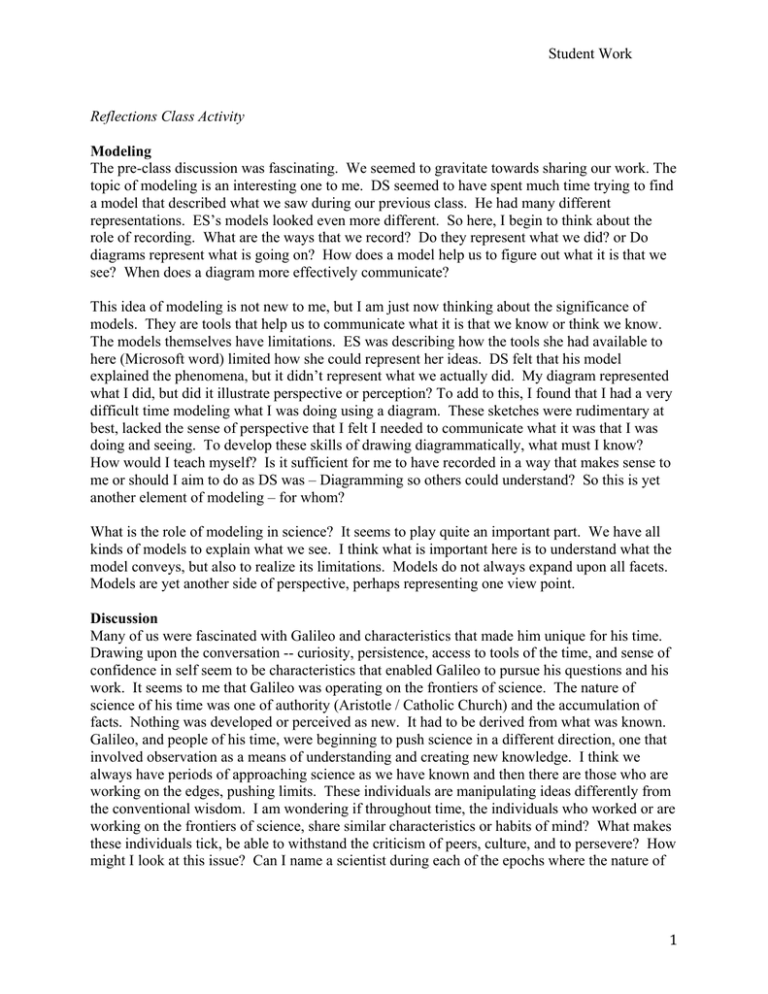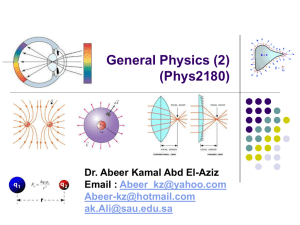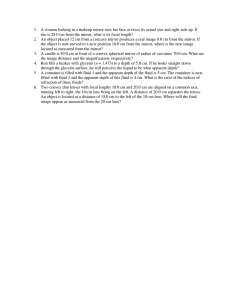Student Work Reflections Class Activity Modeling
advertisement

Student Work Reflections Class Activity Modeling The pre-class discussion was fascinating. We seemed to gravitate towards sharing our work. The topic of modeling is an interesting one to me. DS seemed to have spent much time trying to find a model that described what we saw during our previous class. He had many different representations. ES’s models looked even more different. So here, I begin to think about the role of recording. What are the ways that we record? Do they represent what we did? or Do diagrams represent what is going on? How does a model help us to figure out what it is that we see? When does a diagram more effectively communicate? This idea of modeling is not new to me, but I am just now thinking about the significance of models. They are tools that help us to communicate what it is that we know or think we know. The models themselves have limitations. ES was describing how the tools she had available to here (Microsoft word) limited how she could represent her ideas. DS felt that his model explained the phenomena, but it didn’t represent what we actually did. My diagram represented what I did, but did it illustrate perspective or perception? To add to this, I found that I had a very difficult time modeling what I was doing using a diagram. These sketches were rudimentary at best, lacked the sense of perspective that I felt I needed to communicate what it was that I was doing and seeing. To develop these skills of drawing diagrammatically, what must I know? How would I teach myself? Is it sufficient for me to have recorded in a way that makes sense to me or should I aim to do as DS was – Diagramming so others could understand? So this is yet another element of modeling – for whom? What is the role of modeling in science? It seems to play quite an important part. We have all kinds of models to explain what we see. I think what is important here is to understand what the model conveys, but also to realize its limitations. Models do not always expand upon all facets. Models are yet another side of perspective, perhaps representing one view point. Discussion Many of us were fascinated with Galileo and characteristics that made him unique for his time. Drawing upon the conversation -- curiosity, persistence, access to tools of the time, and sense of confidence in self seem to be characteristics that enabled Galileo to pursue his questions and his work. It seems to me that Galileo was operating on the frontiers of science. The nature of science of his time was one of authority (Aristotle / Catholic Church) and the accumulation of facts. Nothing was developed or perceived as new. It had to be derived from what was known. Galileo, and people of his time, were beginning to push science in a different direction, one that involved observation as a means of understanding and creating new knowledge. I think we always have periods of approaching science as we have known and then there are those who are working on the edges, pushing limits. These individuals are manipulating ideas differently from the conventional wisdom. I am wondering if throughout time, the individuals who worked or are working on the frontiers of science, share similar characteristics or habits of mind? What makes these individuals tick, be able to withstand the criticism of peers, culture, and to persevere? How might I look at this issue? Can I name a scientist during each of the epochs where the nature of 1 Student Work science was shifting? Could I compare approaches and characteristics? Does a common profile emerge? DS also brought up the idea of general science versus specialization. If you are to specialize, you do need a body of knowledge related to that field. How to you get from A to B? Also, what is the value of recreating past knowledge? Can you possibly do all of this recreating and make great strides in new learning? These latter two ideas are percolating within me. When teaching and crafting units of study, a tension exists between what to teach and how to teach. To teach, using an inquiry approach requires a great deal of time and a certain climate, one that invites observation, questioning, and investigation. It also requires teacher and learner to be comfortable with messy learning. I also feel that the teacher has to have some level of expertise with the subject matter. Expertise allows the teacher to guide, to question, to bring out materials that might invite discovery of critical parts of the subject matter. Yet, on the other hand, there are some parts of a concept that may not be obvious from observation alone. How do you create learning opportunities so that learners see these non-obvious causal relationships? Where would inquiry be here? Then, what about time? There is so much knowledge that has come before us. We can’t possibly recreate it all. I can see from the structure of this class, that you are providing readings that shed light on the time period or on how various authors interpreted events. This adds to the depth of knowledge and I do not have to recreate it all, just think more critically. MS raised an interesting point that I believe is worth thinking about, especially in light of science education reform – how do we wrap our heads around the value of inquiry and at the same time deal with scale and sustainability? Viewing / Perspective This activity was interesting. I think that within our group, we all had different ideas about what we perceived the activity to be, what the topic might be, and how to go about uncovering more knowledge. The work we did bounced from one idea to the next, each bounce reflecting some new twist based on what we first experienced. Mirrors – how do they help you see perspective? We began with a mirror on the floor with two people trying to see the other in the mirror. How is this possible? Why is the reflection reversed? How does the light travel? Diagrams, words, interpretations were shared. Then we moved onto trying to see how an image changes with distance. First problem, how do you draw what you see when you are increasing further away from the mirror? We divided the mirror into a coordinate grid. Then the person whose image was reflected in the mirror reported the quadrants where her face was seen. As I moved the mirror back, an unexpected event occurred. Leigh’s face became increasing more and more distorted. More thought about this – Is the mirror curved? Does it magnify? We began to look at the second mirror. This turned the investigation towards comparing the two mirrors. At this point, I abandoned the mirror idea. First, some of the ideas weren’t making sense to me. Second, I had a keen interest in building one of the persectographs. I wanted to understand how one worked. Some of us turned our attention to studying the pictures and trying to build one of Druer’s devices. This process created all kinds of issues. How would we fix the eye? What was the purpose of the two frames? How do you punch or draw holes on the paper when the string is in the way? How do we use the materials we have to replicate what might have been done? We had an interesting set up – paper on wall, right angle to frame anchored in clamp, eye position string (string a) fixed on door knob (didn’t realize that this needed a weight so it could move), 2 Student Work and an object to draw. When we went to draw the cart, we couldn’t figure out how to record the object’s location on the paper. YY came up with the idea of using a second piece of string (string b) held parallel to the vertical edge of the frame. The place where string a and string b intersected would be where the hole on the paper would go. In the meantime, LJ and DS were exploring another perspectograph, the one with a drawing surface in the frame. DS was interested in the sighting tube. A sighting tube was created and we began to figure out how to use it. In the end, lots of different pieces, but not one machine was built. It’s interesting for me to think about my role in this endeavor. I found that I did not stick with one thing, but bounced back and forth. When confronted with challenge and complexity, I bounced from idea to idea instead of sticking with the problem in front of me. (perhaps this is why I have difficulty focusing on one idea – if it is too hard, I need to move on.) As a member of a team collaborating, this type of behavior does not honor others ideas. For the next class, I would like to spend more time observing my behavior and see how to listen more. The machine that the other group built was interesting. I could see how they manipulated the materials available and constructed an instrument that could be used to draw an object. The discussion about whose perspective really got us looking at where the point of view was located. This demonstration left me wondering how using this machine could help you generalize to how perspective works. We don’t need such a tool today to draw. At what point did the geometry of all of this become clear? Lenses My brief work with lenses and mirrors left me wondering how the thickness and curvature of an object affects the movement of light through the surface. Is magnification a function of curvature? If we had a concave lens, would the object become smaller? Why is it that when you have two lenses superimposed on each other, the object appeared to have the same size? I am thinking that this has much to do with how light travels through different surfaces. The light bends differently through a curved surface than a plane surface. This is something that I might be able to explain with words, but don’t really grasp in my heart. I think this little bit of knowledge would be helpful when constructing a telescope. You must have to create lenses that curve the light in such a way to enlarge the distant object. Then you probably need to something about how two or more lenses would interact. What effects does distance from each other have on the magnification? Is the length of the tube significant? Where would you put the lenses in the tube? Is there a mirror in a telescope? Do these same principles apply to microscopes? Binoculars? I believe this is the direction that I want to take outside of class. I realize I don’t even understand how my glasses work in correcting my vision. Galileo Story I read Pelling’s tale of who invented the telescope and Willach’s tracing of the invention of the spectacles. I did not read part II of Willach’s Long Route to the Invention of the Telescope, but I venture to gain that how is comes to identify the inventor of the telescope will be much different than Pelling’s tale. Pelling seems to be a storyteller, taking moments or events that did occur and fashioning a plausible tale based on human activity and habits. Willach takes a different approach, grounding his ideas in the artifacts of the time. These artifacts involve the actual 3 Student Work object, books, and what was known about a particular region and the materials available to the artisans during the 13th century. In addition, Willach recreated some of the machinery and measured the artifacts himself. He uses so many different sources to weave together his explanation. He also uses comparison to help explain when and where spectacles could have originated from. For example, initial lens (Nimrod) made out of rock-crystal and grounded. There were issues with this method – glass was not clear, numerous scratches, obvious imperfections. How then could spectacles be made using these techniques? He digs deep and proposes another way – glass blowing vs. grinding and a different firing process resulting in a better melting process. Monks, having much expertise in making relic holders, come up with a way to shave curve layers off of glass ball, thus making identical discs for the eyes. The story seems plausible. What is most interesting to me is Willach’s original question – Where did these spectacles come from? Was it a discovery or was it a using of existing science knowledge? He mentions that during this period, all new science knowledge was built upon a solid base of prior knowledge. Where did the idea of using curved glass to correct vision of older eyes originate? From what I can piece together is that there was a moment of serendipity. The monks, in the process of creating the reading stones, discovered that these stones improved the visions of the older monks. What role does serendipity play in discovery? Would the evolution of spectacles have been labeled a “discovery” if the idea of how the eye works come into play? Explorations of Perspectographs I have continued to experiment with the idea of looking through a small hole to draw. This time I tried to recreate Brunelleschi’s peepshow demonstration (see journal pp. 28-29). While sitting, I placed a mirror so I could see a basket of fruit that was behind me. I photographed the image in the mirror. I printed the image, then put a whole in the bottom of the picture. With the picture facing towards the mirror, I looked through the peep hole. What I saw was the fruit basket. I am wondering how this helps me understand perspective. It reinforces the idea of a center point. But I am more curious about how I see what I see? What can I do to show the lines of sight? How do they travel? How will knowing this, help me make sense of how curved lenses work? Reflections as a learner Last semester, when reflecting on critical exploration, I found myself trying to figure out the role of story in the piecing together of knowledge. It seems that each person – the teacher, the learner, and the subject matter, had a story to tell. As the knowledge building evolved, one particular individual’s story might take precedence. Sometimes the stories intersected. During periods of confusion or conflict, it seemed to me competing stories vied for attention. I felt a bit of this during our collaborative phase – we were 4 learners, each with our storyline. If we pursued our individual storylines, then we move about in different planes, creating 4 unique stories. Collaboration seems to lie in the merging of these stories? I am thinking now that collaboration is much like linear perspective. We need to have a common vanishing point. Our sight lines (our stories) can be different, but they need to be heading towards that vanishing 4 Student Work point. So I ask myself, what part of my story as learner, must I give up, to here and respond respectfully to others perspectives and stories? I am also discovering that in the quiet space of my own thinking, I can flesh out what my ideas are; I am okay not knowing. Yet, I find that when I am in a group, I measure my ideas against another’s. I second guess my thinking, my logic. I am not comfortable in my skin. Would I hold up on the frontiers of science? Or am I in the midst of one of these states of ambiguity? Should I look at others ideas as ways into pushing my thinking and understanding? 5 MIT OpenCourseWare http://ocw.mit.edu EC.050 Recreate Experiments from History: Inform the Future from the Past: Galileo January IAP 2010 For information about citing these materials or our Terms of Use, visit: http://ocw.mit.edu/terms.





